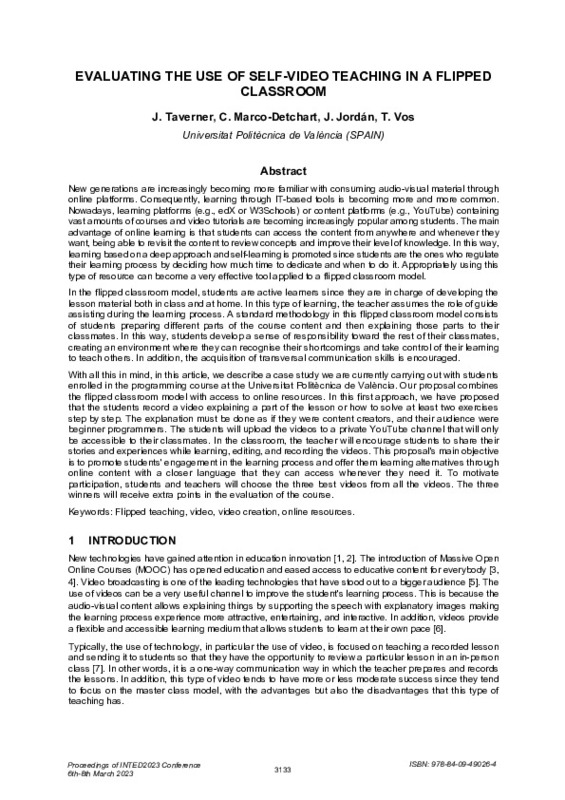|
Resumen:
|
[EN] New generations are increasingly becoming more familiar with consuming audio-visual material through
online platforms. Consequently, learning through IT-based tools is becoming more and more common.
Nowadays, learning ...[+]
[EN] New generations are increasingly becoming more familiar with consuming audio-visual material through
online platforms. Consequently, learning through IT-based tools is becoming more and more common.
Nowadays, learning platforms (e.g., edX or W3Schools) or content platforms (e.g., YouTube) containing
vast amounts of courses and video tutorials are becoming increasingly popular among students. The main
advantage of online learning is that students can access the content from anywhere and whenever they
want, being able to revisit the content to review concepts and improve their level of knowledge. In this way,
learning based on a deep approach and self-learning is promoted since students are the ones who regulate
their learning process by deciding how much time to dedicate and when to do it. Appropriately using this
type of resource can become a very effective tool applied to a flipped classroom model.
In the flipped classroom model, students are active learners since they are in charge of developing the
lesson material both in class and at home. In this type of learning, the teacher assumes the role of guide
assisting during the learning process. A standard methodology in this flipped classroom model consists
of students preparing different parts of the course content and then explaining those parts to their
classmates. In this way, students develop a sense of responsibility toward the rest of their classmates,
creating an environment where they can recognise their shortcomings and take control of their learning
to teach others. In addition, the acquisition of transversal communication skills is encouraged.
With all this in mind, in this article, we describe a case study we are currently carrying out with students
enrolled in the programming course at the Universitat Politècnica de València. Our proposal combines
the flipped classroom model with access to online resources. In this first approach, we have proposed
that the students record a video explaining a part of the lesson or how to solve at least two exercises
step by step. The explanation must be done as if they were content creators, and their audience were
beginner programmers. The students will upload the videos to a private YouTube channel that will only
be accessible to their classmates. In the classroom, the teacher will encourage students to share their
stories and experiences while learning, editing, and recording the videos. This proposal's main objective
is to promote students' engagement in the learning process and offer them learning alternatives through
online content with a closer language that they can access whenever they need it. To motivate
participation, students and teachers will choose the three best videos from all the videos. The three
winners will receive extra points in the evaluation of the course.
[-]
|
|
Agradecimientos:
|
The authors gratefully acknowledge the financial support of Consellería d'Innovació, Universitats,
Ciencia i Societat Digital from Comunitat Valenciana and the European Social Fund (Investing In Your
Future) (APOSTD/2021/227 ...[+]
The authors gratefully acknowledge the financial support of Consellería d'Innovació, Universitats,
Ciencia i Societat Digital from Comunitat Valenciana and the European Social Fund (Investing In Your
Future) (APOSTD/2021/227 and CIPROM/2021/077), the Spanish Ministry of Science (project
PID2021-123673OB-C31) and the Research Services of Universitat Politècnica de València. Jaume
Jordán is supported by grant IJC2020-045683-I funded by MCIN/AEI/10.13039/501100011033 and by
"European Union NextGenerationEU/PRTR".
[-]
|









